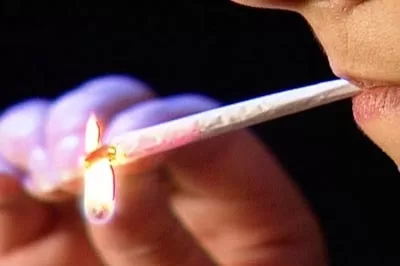- In short: Young women aged 18 to 24 are drinking and using illicit drugs at higher rates than ever before, but there isn’t enough research to tell us why.
- Alcohol remains the most popular drug for all Australians, but pre-Covid gains in harm reduction have tapered off.
- More Australians are supportive of harm-minimisation policies like pill-testing and safe injecting rooms.
Young women aged 18 to 24 are taking illicit drugs at the same rate as young men for the first time since national records began.
The National Drug Strategy Household Survey found that more than one in three young women – or 35 per cent — have taken an illicit drug in the last 12 months, up from 27 per cent in 2019.
The rate for usage among young men of the same age group has remained steady, at 35 per cent.
“Males have historically been more likely to use illicit drugs than females, however 2022–2023 was the first time since monitoring began that females aged 18–24 were as likely to use illicit drugs as males of the same age,” Dr Gabrielle Phillips from the Australian Institute of Health and Welfare (AIHW) said.
The AIHW has been reporting on the drug survey since 1998. This year’s report surveyed more than 21,000 Australians.
Cannabis remains the drug of choice for most Australians, with cocaine coming in second. The use of cannabis among young people increased six per cent between 2019 and 2022-23, and the use of cocaine increased nearly four per cent over the same period.
Robert Taylor from the Australian Drug Foundation said the trend towards young women undertaking more risky drug behaviour is clear, but there isn’t much research into why.
“We have seen that change, we’re not really sure what’s driving that.”
Isabelle Volpe, a PhD candidate at the Drug Policy Modelling Program at the University of New South Wales, said she hopes the data will lead to more research in this space.
She said drug policies tend to focus on drug-users as “masculine” and “rowdy”, but the new data shows that’s not the case.
“The huge benefit of us investing so much in the National Drug Strategy Household Survey having these huge data sets of point towards emerging trends is us being able to see that drug use isn’t just one thing that happens by one kind of person in one sort of space,” she said.
Use of alcohol
The most recent survey also found that the rates of young women and young men binge-drinking are converging, with rates of risky behaviour falling for young men, and increasing for young women.
Two out of five young women aged 18 to 24 consumed alcohol outside of the recommended guidelines — that’s 40 per cent, compared to 45 per cent of young men.
Robert Taylor from the Australian Drug Foundation said young Australians aren’t the only ones drinking at risky levels.
“Unfortunately, risky drinking and harm alcohol continues to be unacceptable levels across the board in the Australian community.”
“We’re seeing about a third of the population drinking in excess of the national guidelines regularly, which is no more than four standard drinks on a single occasion or 10 standard drinks across the course of the week,” Mr Taylor said.
The survey also found that alcohol-related deaths were at a ten-year high, and that more and more people are experiencing harmful behaviour as a result of alcohol use in others.
“We’ve seen huge increases in women experiencing harm from other people’s drinking,” CEO of the Foundation for Alcohol Research and Education, Caterina Giorgi said.
“It’s gone from 2.2 million women saying that they’d experienced verbal abuse or physical abuse or been put in fear, to 2.4 million, and that’s always a really significant concern.”
Women aged 40 to 54 have also recorded the highest increase in rates of liver disease, according to the survey.
Ms Giorgi said the pandemic had disrupted the work organisations like FARE had done to reduce alcohol consumption.
“We saw these really positive trends over the last 20 years leading into COVID. We saw less risky drinking, particularly among young people, which is fantastic. So back in 2001, we had about 70 per cent of kids under 17, say that they drank alcohol. And that dropped to around 30 per cent,” she said.
“What COVID has done is, at best, stopped those really great gains that we’re seeing and stabilised risky drinking among some population groups,” Ms Giorgi said.
“But at worst, particularly among young women, we’re seeing some indicators that things are getting worse.”
Ms Giorgi said alcohol companies were deliberately targeting younger women with new products that are marketed as healthy alternatives to regular booze.
“[They’re] saying things like it’s less calories, and there’s less sugar and there are even products that say that they’re collagen-infused.
“We’re starting to see that in the data now when it comes to drinking and harms,” Ms Giorgi said.
Attitudes towards harm reduction programs
The National Drug Strategy Household Survey found that more Australians are supportive of drug-related harm minimisation policies.
Support for pill-testing rose from 57 per cent in 2019 to 64 in this survey.
“We know this is an evidence-based measure. We know that when people test their drugs, they’re actually less likely to use drugs after you after testing,” Robert Taylor said.
“We also saw an increase in support for overdose prevention sites or supervised injecting rooms, and now a majority of Australians support that as well.”
Isabelle Volpe said Australians have seen the success of these policies.
“You’ve seen two supervised injecting centres open up in Australia and the sky has not fallen in. Same with a pill testing Centre in Canberra, the sky is not falling in.”
“We’re really pleased to see that and pleased to see continuing support for health-based response to personal drug use in the community,” Mr Taylor said.
